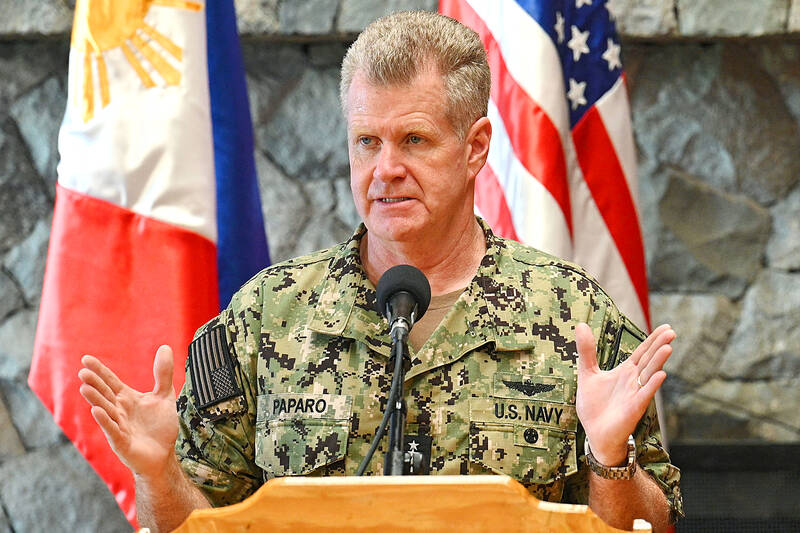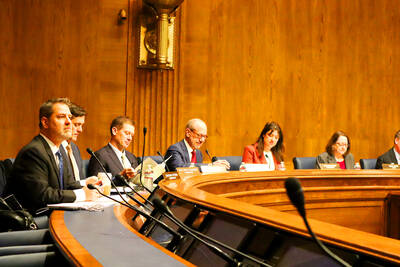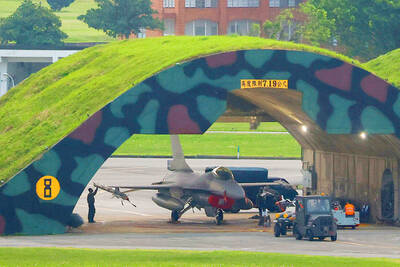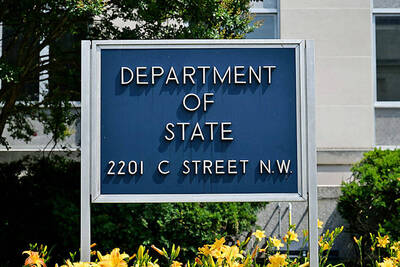China’s military exercises around Taiwan have become so extensive they could be used as a “fig leaf” to mask an invasion, the Financial Times quoted the top US commander in the Indo-Pacific region as saying.
Speaking at the Honolulu Defense Forum on Thursday, US Navy Admiral Samuel Paparo sounded the alarm over the rising alliance of China, Russia and North Korea, calling it an “emerging axis of autocracy.”
The trio have formed a “triangle of troublemakers,” he told the Pacific Forum-sponsored event.

Photo: AFP
The Chinese People’s Liberation Army’s (PLA) surge of activities around Taiwan in the past few years had made it difficult to distinguish a large-scale exercise and preparations for an invasion, Paparo was quoted as saying.
“We’re very close to that [point] where on a daily basis the fig leaf of an exercise could very well hide operational warning,” he said. “Their aggressive maneuvers around Taiwan right now are not exercises as they call them, they are rehearsals. They are rehearsals for the forced unification of Taiwan to the mainland.”
US intelligence indicates that China, Russia and North Korea’s cooperation has extended to coordinating “everything from bomber patrols that penetrate American ADIZ [air defense identification zones] to shared anti-satellite capabilities and advanced submarine technologies from the seabed to the heavens,” the paper quoted Paparo as saying.
Expressing concern over the rise in PLA activity, Paparo said that the US must move quickly to close capability gaps, including the quantity of stockpiled arms that could be used in the Indo-Pacific region.
“Our magazines run low. Our maintenance backlogs grow longer each month... We operate on increasingly thin margins for error,” he was quoted as saying. “Our opponents see these gaps, and they are moving aggressively to exploit them.”
Paparo, who recently hosted a summit on artificial intelligence (AI), said the US should move quickly to obtain and deploy more types of uncrewed weapons systems, as AI could be a “key tool” to help the US detect early signs of a pending attack on Taiwan.
The commander called for urgent reforms at the Pentagon’s procurement system, saying: “Technology alone is not going to win this fight.”
“Procurement at the speed of combat, not at the speed of committees,” he added.
In related news, the Japanese Ministry of Defense told Nikkei that the PLA Navy last year sailed 68 times into Japan’s southwestern seas, three times the frequency of regional Chinese military activity from 2021.
Speaking at a post-Cabinet news conference, Japanese Minister of Defense Gen Nakatani said that the number included all ship movements Tokyo had positively identified as Chinese military.
Last year also marked the first time Chinese military aircraft entered Japanese airspace and the Chinese aircraft carrier Liaoning’s (遼寧) first-ever navigation near the boundary of Japanese territorial waters, he said.
These incidents were highly concerning and posed an unprecedentedly severe strategic challenge to the rules-based international order, he said.
Japan would conduct surveillance and take other necessary measures in the sea and air surrounding Japan to ensure nothing can go awry and respond to incidents with calm determination, he was cited as saying.
Additional reporting by CNA

MISINFORMATION: The generated content tends to adopt China’s official stance, such as ‘Taiwan is currently governed by the Chinese central government,’ the NSB said Five China-developed artificial intelligence (AI) language models exhibit cybersecurity risks and content biases, an inspection conducted by the National Security Bureau (NSB) showed. The five AI tools are: DeepSeek, Doubao (豆包), Yiyan (文心一言), Tongyi (通義千問) and Yuanbao (騰訊元寶), the bureau said, advising people to remain vigilant to protect personal data privacy and corporate business secrets. The NSB said it, in accordance with the National Intelligence Services Act (國家情報工作法), has reviewed international cybersecurity reports and intelligence, and coordinated with the Ministry of Justice Investigation Bureau and the National Police Agency’s Criminal Investigation Bureau to conduct an inspection of China-made AI language

LIMITS: While China increases military pressure on Taiwan and expands its use of cognitive warfare, it is unwilling to target tech supply chains, the report said US and Taiwan military officials have warned that the Chinese People’s Liberation Army (PLA) could implement a blockade within “a matter of hours” and need only “minimal conversion time” prior to an attack on Taiwan, a report released on Tuesday by the US Senate’s China Economic and Security Review Commission said. “While there is no indication that China is planning an imminent attack, the United States and its allies and partners can no longer assume that a Taiwan contingency is a distant possibility for which they would have ample time to prepare,” it said. The commission made the comments in its annual

BOOST IN CONFIDENCE: The sale sends a clear message of support for Taiwan and dispels rumors that US President Donald Trump ‘sold out’ the nation, an expert said The US government on Thursday announced a possible sale to Taiwan of fighter jet parts, which was estimated to cost about US$330 million, in a move that an expert said “sends a clear message of support for Taiwan” amid fears that Washington might be wavering in its attitude toward Taipei. It was the first announcement of an arms sale to Taiwan since US President Donald Trump returned to the White House earlier this year. The proposed package includes non-standard components, spare and repair parts, consumables and accessories, as well repair and return support for the F-16, C-130 and Indigenous Defense Fighter aircraft,

CHECKING BOUNDARIES: China wants to disrupt solidarity among democracies and test their red lines, but it is instead pushing nations to become more united, an expert said The US Department of State on Friday expressed deep concern over a Chinese public security agency’s investigation into Legislator Puma Shen (沈伯洋) for “secession.” “China’s actions threaten free speech and erode norms that have underpinned the cross-strait ‘status quo’ for decades,” a US Department of State spokesperson said. The Chongqing Municipal Public Security Bureau late last month listed Shen as “wanted” and launched an investigation into alleged “secession-related” criminal activities, including his founding of the Kuma Academy, a civil defense organization that prepares people for an invasion by China. The spokesperson said that the US was “deeply concerned” about the bureau investigating Shen